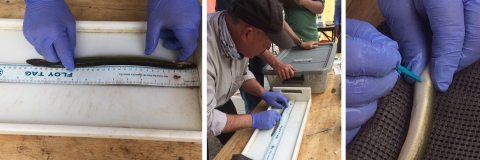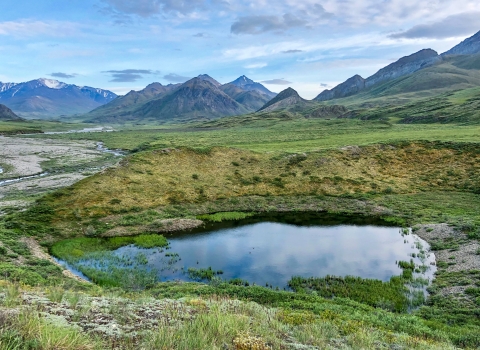American eel (Anguilla rostrata) are the only freshwater eel species found in North America and they have an extraordinary life cycle. Born in the Sargasso Sea (a region of the North Atlantic Ocean), the eel will migrate thousands of miles to freshwater rivers and streams where they will spend 10–25 years before returning back to the Sargasso Sea when it’s time to reproduce.
These incredible migrations occur across the eastern shore of the Atlantic Ocean from Greenland all the way down to Venezuela, with some eel even finding their way up the Mississippi River or into the Great Lakes.
On a warm spring day, a team of scientists gather at the Dam №4 hydroelectric power plant on the Potomac River near Shepherdstown, West Virginia. The team begins setting up what is jokingly referred to as MESH — a mobile eel surgical hospital (not to be mistaken for MASH, the hit television series set during the Korean War). Nearby, a hundred American Eel swim around in large white coolers, protected under the shade of a canopy. Little do the eel know, they are about to become the center of an exciting study.
But at this spot on the Potomac River, after already ascending the seemingly insurmountable rock cliffs at Great Falls, the eel face an impasse at Dam №4; the dam is too tall and their migration is blocked. Not all is lost for the eel, though. The U.S. Fish and Wildlife Service’s Coastal Program is working with a team of partners to build a passage, called an eelway, that will allow the eel to travel beyond the dam and continue their migration upriver.
The Eel World Reality
The lucky eel being held streamside are about to be implanted with acoustic transmitters — special microchips that will allow biologists to track where the eel are in the river and learn about their habitat preferences. These tags, the size of a grain of wild rice, are specially created by the Pacific Northwest National Laboratory to track American eel.
There are six acoustic receivers placed in the river below the dam. As a tagged eel swims by, the receiver reads the tag and documents when and how often the fish was in the area. By tracking the eel, scientists can learn how the fish behave — specifically aiming to find out more about their preferred water flow, which shoreline they spend more time along, and how much time they spend searching for habitat. This information will help scientists build a successful eelway.
As the day begins, the team sets up the MESH and prepares for the task of tagging 100 slippery eel; the operating pad is soaked with water to protect the eel, a dilute clove oil bath is readied to help put the eel to sleep during surgery, the scalpel and acoustic transmitters are set, and the operating station is rinsed with a sanitizing agent to prevent infections. Eel have an incredible ability to scale natural barriers (like the Potomac Great Falls!) and several willful individuals attempt escapes each time the cooler opens!
Dave Sutherland, a Coastal Program biologist with the Chesapeake Bay Field Office, has the honor of being Hawkeye Pierce, the head surgeon in our MESH unit. To begin, an eel is placed in a dilute solution of clove oil as an anesthesia. Each acoustic tag is scanned and the tag’s identification number is recorded so the eel can be individually tracked. When the eel is asleep, the surgery begins; a small incision is made in the abdomen, an acoustic tag is quickly slipped in, and Dave rubs a protective layer of the eel’s mucus over the abdomen to protect the incision. The whole operation takes about 45 seconds and then the eel are placed in a tub of cool water to recover.
Well Dam, Eel Need a Passage
Historically, American eel made up 50% or more of the fish in the Potomac River and were a staple food item for Native Americans and settlers. Over time, more and more dams were built across America’s waterways, blocking access to upstream habitats, which threatens American eel populations. Installing fish passages, like eelways, will allow these journeying fish to reach portions of the river that they have been excluded for over a 180 years.
Often a food source for many other fish, birds, and mammals when small, as the eel get bigger, they become a predators and help keep the food chain in check. American eel also help freshwater mussels reproduce — mussel larvae temporarily attach to fish gills in order to transform into adult mussels. Freshwater mussels are just one example of how restoring access for eels can benefit an entire ecosystem.
For now, biologists are focusing on these 100 eels to learn more about their movement and habitat use below the dam. The eelway is set to be installed by the end of summer to connect American eel to their historical habitat and open a range of river to sustain the next generations of American eel. Just like your favorite episodes of MASH, you can catch the great American eel migration on rerun each year in freshwater rivers and streams across the eastern coast.
------
Partnering on this project is the U.S. Fish and Wildlife Service Coastal Program, Department of Energy and Pacific Northwest National Laboratory, West Virginia Division of Natural Resources, Maryland Department of Natural Resources, NOAA, U.S. Army Corps of Engineers, National Parks Service, West Virginia University, U. S. Geological Survey, and Cube Energy.
Jessica Collier is a 2018 Sea Grant Knauss Fellow and the Coastal and Marine Resource Specialist with the U.S. Fish & Wildlife Service Coastal Program. Follow her on Twitter at @Aqua_Amare!






